

SellerEngine. Sign In. Construction of new ribozymes requiring short regulator oligonucleotides as a cofactor. Regular article a Graduate School of Pharmaceutical Sciences Hokkaido University, Sapporo 060-0812, Japan Received 28 January 2000, Revised 2 May 2000, Accepted 3 May 2000, Available online 25 March 2002 Choose an option to locate/access this article: Check if you have access through your login credentials or your institution Check access DOI: 10.1006/jmbi.2000.3825 Get rights and content Abstract A hairpin loop and an oligonucleotide bound to the loop form one-half of the pseudoknot structure.
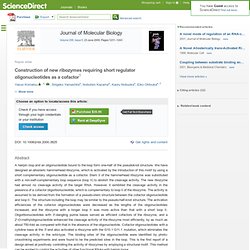
Keywords pseudoknot; ribozyme; catalytic RNA; allosteric control; regulation Abbreviations. Construction of new ribozymes requiring short regulator oligonucleotides as a cofactor. Synthesis of fibrous nanoparticle aggregates by femtosecond laser ablation in air. Nanoparticles, Proteins, and Nucleic Acids: Biotechnology Meets Materials Science - Niemeyer - 2001 - Angewandte Chemie International Edition. Sensitive and Robust Colorimetric Sensing of Sulfide Anion by Plasmonic Nanosensors Based on Quick Crystal Growth. A highly sensitive and selective method for colorimetric sensing of sulfide anions in aqueous solutions is illustrated.
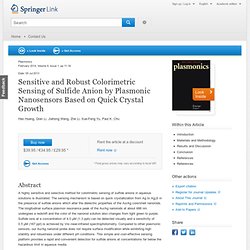
The sensing mechanism is based on quick crystallization from Ag to Ag2S in the presence of sulfide anions which alter the dielectric properties of the Au/Ag core/shell nanorods. The longitudinal surface plasmon resonance peak of the Au/Ag nanorods at about 686 nm undergoes a redshift and the color of the nanorod solution also changes from light green to purple.
Sulfide ions at a concentration of 4.0 μM (1.3 ppb) can be detected visually and a sensitivity of 0.5 μM (167 ppt) is achieved by Vis–near-infrared spectrophotometry. Compared to other plasmonic sensors, our Au/Ag nanorod probe does not require surface modification while exhibiting high stability and robustness under different pH conditions. Urine for plasmonic nanoparticle-based colorimetric de... [Small. 2013] Optics InfoBase - Colorimetric Sensors using Plasmonics Grating on a Metallic Mirror. On-Chip Colorimetric Detection of Cu2+ Ions via Density-Controlled Plasmonic Core–Satellites Nanoassembly - Analytical Chemistry. † World Class University Program of Chemical Convergence for Energy and Environment, School of Chemical and Biological Engineering, Institute of Chemical Processes, Seoul National University, Seoul 151-742, Republic of Korea ‡ Department of Chemical and Biomolecular Engineering, Sogang University, Seoul, 121-742, Republic of Korea Anal.

Chem., 2013, 85 (16), pp 7980–7986 DOI: 10.1021/ac401796q Publication Date (Web): July 18, 2013 Copyright © 2013 American Chemical Society Section: Abstract We report on an on-chip colorimetric method for the detection and analysis of Cu2+ ions via the targeted assembly of plasmonic silver nanoparticles (2.6 nm satellites) on density-controlled plasmonic gold nanoparticles (50 nm cores) on a glass substrate. Citing Articles View all 3 citing articles Citation data is made available by participants in CrossRef's Cited-by Linking service. This article has been cited by 1 ACS Journal articles (1 most recent appear below). Vertically stacked plasmonic nanoparticles in a circular arrangement: a key to colorimetric refractive index sensing - Nanoscale. Quantum Plasmonics: Optical Properties of a Nanomatryushka - Nano Letters.
† Department of Physics and Astronomy, MS 61, Rice University, Houston, Texas 77005, United States ‡ Department of Physics, Yeshiva University, New York, New York 10016, United States Nano Lett., 2013, 13 (12), pp 5873–5879 DOI: 10.1021/nl402662e Publication Date (Web): November 8, 2013 Copyright © 2013 American Chemical Society Section: Abstract Quantum mechanical effects can significantly reduce the plasmon-induced field enhancements around nanoparticles.
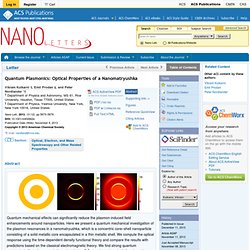
Additional figures: (S1) Optical absorption spectra for larger nanomatryushkas calculated using TDDFT; (S2) Ground state properties for a fictitious system of workfunction 4 eV compared to Au NM; (S3) Optical absorption spectra for a fictitious system of workfunction 4 eV calculated using TDDFT. Citing Articles View all 7 citing articles Citation data is made available by participants in CrossRef's Cited-by Linking service. This article has been cited by 2 ACS Journal articles (2 most recent appear below). Nanosphere-in-a-Nanoshell: A Simple Nanomatryushka† - The Journal of Physical Chemistry C. Department of Chemistry, Rice University, Houston, Texas 77005, Laboratory for Nanophotonics, Rice University, Houston, Texas 77005, Department of Electrical and Computer Engineering, Rice University, Houston, Texas 77005, Department of Physics and Astronomy, Rice University, Houston, Texas 77005, Department of Bioengineering, Rice University, Houston, Texas 77005 J.
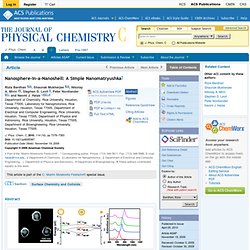
Phys. Chem. When aluminum outshines gold: Research details aluminum's valuable plasmonic properties. (Phys.org) —Humble aluminum's plasmonic properties may make it far more valuable than gold and silver for certain applications, according to new research by Rice University scientists.
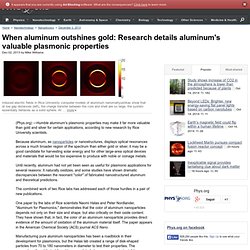
Because aluminum, as nanoparticles or nanostructures, displays optical resonances across a much broader region of the spectrum than either gold or silver, it may be a good candidate for harvesting solar energy and for other large-area optical devices and materials that would be too expensive to produce with noble or coinage metals. Until recently, aluminum had not yet been seen as useful for plasmonic applications for several reasons: It naturally oxidizes, and some studies have shown dramatic discrepancies between the resonant "color" of fabricated nanostructured aluminum and theoretical predictions.
The combined work of two Rice labs has addressed each of those hurdles in a pair of new publications. "The reason we use gold and silver in nanoscience is that they don't oxidize. Aptamer-conjugated gold nanoparticles fo... [Nanomedicine (Lond). 2013] Preparation of aptamer-linked gold nanoparticle purple aggregates for colorimetric sensing of analytes : Abstract : Nature Protocols. Derek_Mitchell_3.pdf. A PDMS/paper/glass hybrid microfluidic biochip integrated with aptamer-functionalized graphene oxide nano-biosensors for one-step multiplexed pathogen detection.